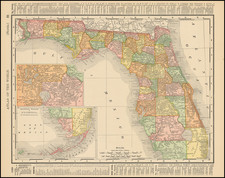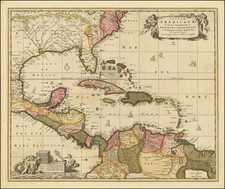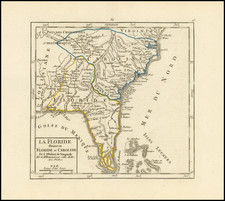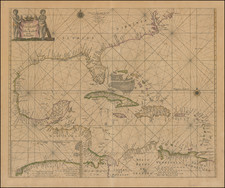Presentation Copy From Mapmaker To One of The Map's Principal Sources
Rare cornerstone map of Florida, produced during the Third Seminole War, with presentation inscription from the maker, Joseph C. Ives, to one of the officers who surveyed the region, Captain H[arvey]. A[bner]. Allen, 2d Artillery."
The map is accompanied by the very rare 42 page Memoir to accompany a Military Map of The Peninsula Of Florida, published in 1856.
Joseph Ives' Military Map of the Peninsula of Florida . . . was the first map to compile the numerous military and government surveys of the southern part of Florida undertaken over the prior 4 decades into a single map. The map's detailed is unparalleled. While the US Army had been active in Florida for 4 decades, including a number of different Seminole Wars, Florida remained largely unsurveyed and unmapped.
In the introduction to the Memoir, Ives notes that the existing military surveys and maps were problematic, varying dramatically in quality and accuracy. The variable quality and lack of an integrated general map of the region was a paramount concern for the US Military and Florida government. To address the problem, Ives undertook a meticulous review of the available military surveys (with a critical eye to work around inaccuracies and inconsistencies), in combination with US Land Office maps and Coast Survey charts, in order to produce what was unquestionably the most advanced map of South Florida to date.
As a military map, one of Ives' primary goals was to show existing roads and infrastructure, and to identify prospective new routes between Florida's numerous Army encampments and forts. “Wagon Roads,” Blazed Trails,” and “Trails,” are each separately classified, with separate commentary by Ives in the Memoir addressing the import of his work.
Ives’ map is also a profound advancement of the mapping of Florida's topography. Ives differentiates between 8 different types of land, from Swamp to Saw Grass. Ives also calls out the problematic nature of Florida’s ever and rapidly changing low-lying lands and their wet conditions. Different forests are identified, as are the locations of battlegrounds, forts (occupied and unoccupied), Native American settlements, towns and dwellings.
Published in April 1856, the final update includes a battle fought on March 29, 1856 near the Wahika Inlet and just south of Marco Island and Gallivan Bay.
The Memoir and map note that Ives' had produced these works under the direction of Captain A.A. Humphreys and by order of Jefferson Davis, then Secretary of War. While the work was undertaken under Davis's orders, the Memoir and map may in fact have been a private publication (with both printer and publisher in New York, rather than Washington, DC), and the vast majority of surviving copies seem to have been immediately distributed by Ives and others to senior military officers.
Joseph Christmas Ives (1828-1868) graduated from the U. S. Military Academy in 1828. Ives is perhaps best known for his next assignment, a survey and description of the Colorado River (“Report Upon the Colorado River of the West”), resulting from an expedition he headed in 1857-58. During the ensuing Civil War, the New York born Ives fought for the Confederacy and appointed to Davis’s personal staff, serving as the chief engineer for the defense of southeast coastline.
Provenance
The present example of the map would seem to have been given by Ives to one of its contemporary sources, Captain Harvey Abner Allen of the Second Infantry, who had served in Florida from 1852 to 1856.
The inside cover is inscribed "Capt. H[arvey]. A[bner]. Allen, 2nd Arty, with the respect of J.C. Ives Lt. Top. Engrs."
A further/later pencil note reads: "Your Father [H.A. Allen] drew part of these maps & explored Lake Oc-be- he crossed it in an open boat with two soldiers."
Ives notes in the text of hims Memoir that "the information regarding Lake Okeechobee was drawn from the reports and maps of Lieut. Gunnison, Topographical Engineers, and Capt. Allen and Lieut. Benson, Second Artillery. "
Allen had, on February 18, 1855, been ordered to "open a practicable road for wagons from Fort Jupiter to the Blockhouse to be established upon the Eastern side of Lake Okeechobee. Cap'. Harvey A. Allen, 2 nd Artr '. Has been directed to blaze the above mentioned route."
Harvey Abner Allen
Harvey Abner Allen (1818 – 1882) was an officer in the United States Army who served as the fourth commander (Military Governor) of the Department of Alaska, from September 20, 1871 to January 3, 1873.
Born in New Bern, North Carolina, Allen was the son of Brigadier General Vine Allen, a prominent North Carolina politician and businessman. He graduated from West Point in 1841, and was assigned to the 2nd Artillery Regiment, serving with this unit for most of his career.
His early career was spent in New York. From 1846 to 1848, he was active during the Mexican War, including the Siege of Vera Cruz, Battle of Cerro Gordo, capture of San Antonio, Battle of Chapultepec and Capture of Mexico City. He served after the war at Jefferson Barracks, Missouri and Santa Fe, New Mexico, before transferring to Fort Moultrie, SC in 1850.
Allen served in Florida during the "hostilities with the Seminole from 1852 to 1856.
Following his activity in Florida, he served again in New York and Washington DC, rising to the rank of Major during the Civil War.
Third Seminole War
The third and final Seminole War started when a surveying expedition under command of Lieutenant Hartsuff, who stumbled upon a garden owned by Billy Bowlegs, an important local Seminole chief. Hartsuff's party began to destroy the garden and were discovered doing so by Bowlegs. He objected to the destruction of his crops and was brutalized by the soldiers. While Hartsuff's team was preparing to leave for Fort Myers the next morning, they were attacked by Bowlegs and a group of Seminole warriors. Four of the eleven members of the party were killed and scalped, while the rest were able to make it back to Fort Myers. Hartsuff's route and the location of the skirmish are both noted on this map.
The war continued for three years. Bowlegs was eventually convinced to accept a cash payment from the United States government, and he moved his people west to the Indian Territory in what is now Oklahoma. It is said that when they went through New Orleans on their way to the Indian Territory, Bowlegs had two wives, several children, $100,000 in cash, and many slaves with him. When Bowlegs established himself in the Indian Territory, he was said to have been one of the bigger slaveholders in the region.
The small territory that was still occupied by the Seminole Indians at the outset of the third war, is described on this map in great detail. The map shows the extent to which the Indians had been pushed deep into Big Cypress Swamp and up to the northern edge of the Everglades by the previous wars and the policies of Andrew Jackson. Ives gives a good sense of the distribution of the Seminoles who had remained in Florida to the mid-1850s with the depiction of the villages in Big Cypress Swamp: Billy's Town, Billy Bowlegs Old Town, Sam Jones Town, Bowlegs Town, Stuttering Bill's, etc.
At least seven battlegrounds from the Second and Third Seminole Wars are shown on the map. They date up to 1856 and include the following:
- Battle of Okeechobee December 25, 1837
- Jesup's Battle January 24, 1838
- Battle of December 20, 1841
- Lieut. Hartsuff's Skirmish of December 1855 (marking the beginning of the third war)
- Battle of January 1856
- Battle of April 7, 1856
- Battle of March 29, 1856 (the map was published the following month)
The map illustrates over 45 forts or military depots. Interestingly the vast majority of these are unoccupied; of the forts shown, only nine are labeled occupied on the map. The map illustrates the following occupied forts:
- Fort Deynaud
- Fort Capron
- Fort Green
- Fort Hartsuff
- Fort Dulaney
- Fort Simon Drum
- Fort Dallas
- Fort Frazer
- Fort Meade
And these unoccupied forts:
- Fort Lauderdale
- Old Fort Lauderdale
- Fort Jupiter
- Old Fort Jupiter
- Fort T. B. Adams
- Fort Thompson
- Fort Pierce
- Fort Loyd
- Fort Van Swearingen
- Fort Drum
- Fort Vinton
- Fort Kissimmee
- Fort Chokkonikla
- Fort Myakka
- Fort Arbuckle
- Fort Clinch
- Fort Keais
- Fort Doane
- Fort Shackelford
- Fort Myers
- Fort Hamer
- Fort Crawford
- Fort Brooke
- Fort Carroll
- Fort Chokkonikla
- Fort Harrell
- Fort McRae
- Fort Westcott
- Fort Simmons
- Fort Center
- Fort Henry
- Old Depot No. 2
- Temporary Depot No. 1
- Temporary Depot No. 2 / Old Fort Foster
- Fort Basinger
- Fort Gardner
In addition to the battles and forts described on the map, its other major contribution to our understanding of the military history of South Florida is its inclusion of the routes of 25 military surveys and expeditions spread between the Second and Third Seminole Wars. The routes are as follows:
- Screven's route
- Major Lauderdale's route
- Colonel Harney's route
- Colonel Taylor's route
- General Twigg's route
- Colonel P. Smith's route
- Captain Waites's route
- Captain Wright's route
- General Eustis's route
- Captain Pratt's route
- Colonel Taylor's route
- Lieutenant Hartstuff's route of 1835
- Captain Allen's route of 1838
- Colonel Davenport's route of 1839
- Major Graham's route of January 1842
- Captain Wade's route of 1842
- Captain Wade's return route
- Captain Ker's route of 1842
- Lieutenant Benson's route of 1854
- Captain Dawson's route of 1855
- Lieutenant Haines's route 1855
- Major Hays's route 1855
- Lieutenant A.P. Hill's route of 1855
- Lieutenant Platt's route of 1855
- Major Hayes's route of 1855
Human and Natural Geography
The map features a stunning level of ecological detail; six categories of land are differentiated: sawgrass, swamp, marsh, scrub, wet prairie, dry prairie, wet hammock, and dry hammock. The map also specifies the following forest types: pine, palmetto, oak, cypress, and "koontee" (also called "koonti", and now referred to as Florida arrowroot or wild sago).
The map's coverage of the entirety of the Everglades and surrounding areas, as well as the present-day metropolitan areas of Miami, Palm Beach, Tampa Bay, and Fort Myers, offers a peerless opportunity to contrast south Florida's pre-development landscape with how it looks today.
The map shows very few American towns. Tampa is shown as a village and there are single dwellings scattered around the bay but other than that there is very little development. There are collections of houses near Indian River and in the Florida Heartland. In fact, there were few enough houses that Ives could name the individual owners of many of them.
Two lighthouses are shown, namely those on Key West and at Cape Florida on Key Biscayne.
Particular care was taken to describe various transportation routes: wagon roads, blazed routes, and trails are shown separately. Indian boundaries are shown. There are proposed canal routes as well.
Joseph Christmas Ives
The map was compiled by Joseph Christmas Ives (1829-1868), under the orders of then-Secretary of War of the United States, Jefferson Davis. Ives was an important figure in the mapping of the American frontier. He graduated from the United States Military Academy in 1852, and from 1853 to '54 he served as a Second Lieutenant with the Topographical Engineers on Whipple's Pacific Railroad survey of the 35th parallel.
After the completion of his map of Florida in April 1856, Ives led an expedition over two years, to explore the upper Colorado River. As a result of this expedition he was responsible for the earliest scientific mapping of the Grand Canyon and its environs.
From 1859 to 1860, after his expedition out west, Ives worked as an engineer and architect on the Washington Monument. At the beginning of the Civil War he declined a promotion in the U.S. Army. And in spite of having been born in New York City, Ives took a commission with the Confederates. He filled several engineering roles until he became aide-de-camp, with the rank of colonel, to President Jefferson Davis. He served in this capacity from 1863 to 1865. It is noteworthy that he also served under Jefferson Davis when Davis was Secretary of War during the 1850s. It has been suggested that this relationship is what led Ives to fight for the Confederacy.
After the war Ives returned to New York City and died there on November 12th, 1868.
The map echoes Washington Hood's 1838 Map of the Sea of War in Florida, and McKay & Blake's 1839 derivative map. Ives's map, however, is much larger and more detailed.
Rarity
The map and report are of the utmost rarity.
We acquired and resold the example offered at PBA Galleries in 2016. Prior to 2016, we note an example at Sothebys in 1990 and the Streeter copy in 1967 as the only two examples at auction in the past 70 years.
Christopher R. Eck, South Florida's Prelude to War: Army Correspondence Concerning Miami, Fort Dallas, and the Everglades Prior to the Outbreak of the Third Seminole War, 1850-1855 (Tequesta)











![[ Georgia Coast ] Sex alia flumina a Gallis observata. IIII.](https://storage.googleapis.com/raremaps/img/small/97965.jpg)


![[ Florida Indians - Preparations for a Feast ] Conviviorum apparatus](https://storage.googleapis.com/raremaps/img/small/98462.jpg)

